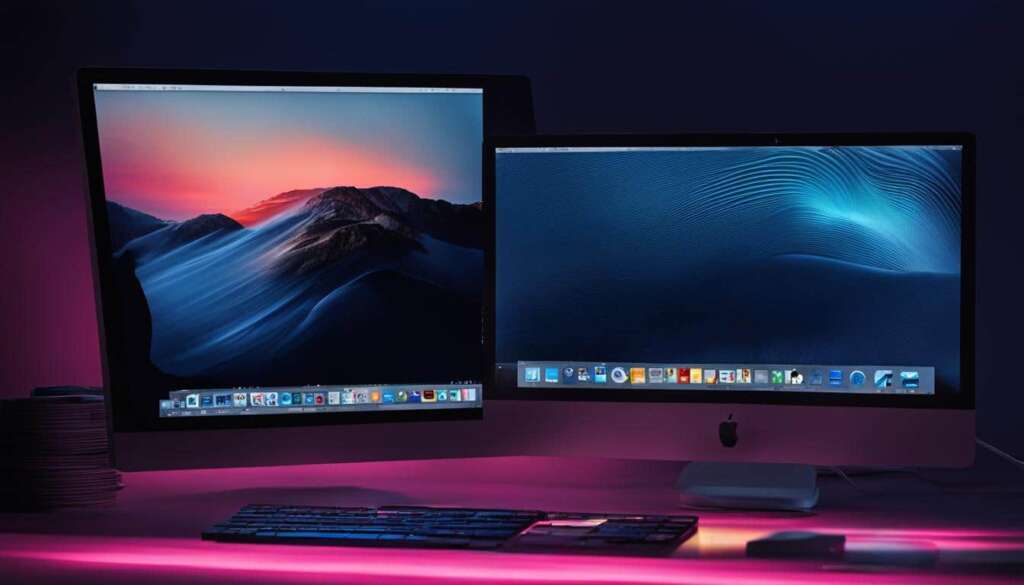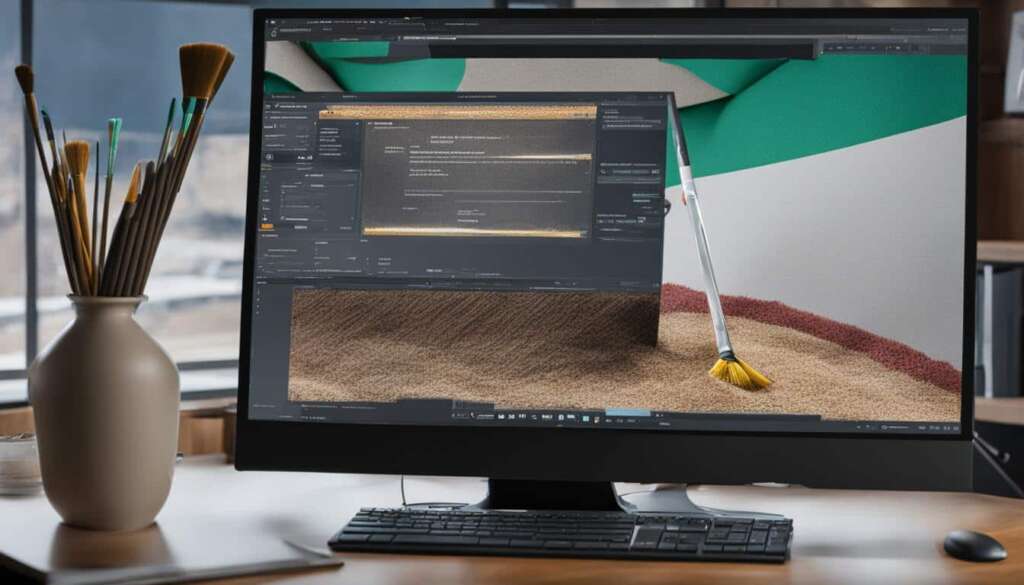Table of Contents
Welcome to the ultimate guide on how to power up your Mac desktop and unlock its full potential. Whether you’re a tech enthusiast or a newbie to the Mac world, this step-by-step tutorial will help you master the art of starting your Mac desktop with ease.
Are you ready to embark on a journey of discovery and empowerment? Let’s dive into the exciting world of Mac desktop startup!
Starting your Mac desktop is a breeze, and we’re here to guide you every step of the way. By following these simple instructions, you’ll unleash the power of your Mac and witness its stunning capabilities.
Setting Up Your Mac Desktop
Before you can switch on your Mac desktop and start using it, you need to ensure that it is properly set up. This involves connecting all the necessary cables and peripherals, such as the keyboard, mouse, and monitor. Having a well-organized and functional setup will provide you with a seamless experience as you activate your Mac desktop.
Begin by arranging your cables, making sure they are untangled and free from any obstructions. Proper cable management not only enhances the aesthetics of your workspace but also improves the functionality and longevity of your devices.
Next, connect your peripherals to their respective ports on the back of your Mac desktop. Ensure that each connection is secure and properly inserted. This includes plugging in the keyboard, mouse, and monitor, as well as any additional accessories you may have, such as external hard drives or printers.
Once everything is connected, take a moment to inspect your setup and make any necessary adjustments. Ensure that your monitor is positioned at a comfortable viewing angle and that your keyboard and mouse are ergonomically positioned for optimal comfort and efficiency.
Having a well-rounded and ergonomic setup will significantly enhance your productivity and overall experience while using your Mac desktop. By taking the time to properly set up your workspace, you are setting the foundation for a seamless and enjoyable computing journey.
Now that you have successfully set up your Mac desktop, you are ready to move on to the next step: switching it on and activating its full potential.
Key Steps to Setting Up Your Mac Desktop:
- Organize and untangle your cables.
- Connect the keyboard, mouse, and monitor to the respective ports.
- Adjust the monitor position and ensure ergonomic placement of the keyboard and mouse.
Benefits of a Well-Set Up Mac Desktop:
- Enhanced aesthetics with proper cable management.
- Improved functionality and longevity of devices.
- Optimal viewing angle and ergonomic positioning for increased productivity.
Powering On Your Mac Desktop
To power on your Mac desktop, locate the power button on the back of the computer. Press and hold the power button for a few seconds until you hear a startup chime or see the Apple logo on the screen. This signifies that your Mac is booting up and initializing its operating system.
If your Mac doesn’t turn on, it could be due to a variety of reasons. Firstly, ensure that your Mac desktop is properly connected to a power source. Check that the power cable is securely plugged in and that the outlet is functioning correctly. If you are using a power strip or surge protector, verify that it is turned on and working.
If the power connection is not the issue, there may be internal hardware problems preventing your Mac from powering on. In this case, it is recommended to seek professional assistance from an Apple Authorized Service Provider or visit an Apple Store for further troubleshooting and apple repairs.
Note: If you have recently experienced a power outage or your Mac desktop unexpectedly shut down, it is possible that the startup process is taking longer than usual. Allow your Mac a few extra seconds to complete the booting process before considering it unresponsive.
Troubleshooting Startup Issues
If your Mac desktop is encountering problems during startup, there are several troubleshooting steps you can take to resolve the issue. By following these steps, you can diagnose and fix common startup problems and get your Mac up and running smoothly.
First, it’s important to check the physical connections of your Mac desktop. Ensure that all cables, including the power cable, are securely connected to their respective ports. Additionally, verify that the power source is working correctly by plugging in another device and confirming it functions properly.
If the connections and power source are not the cause of the problem, you can try resetting the System Management Controller (SMC). This can resolve issues related to power management and may help your Mac start up successfully. The process for resetting the SMC varies depending on the model of your Mac desktop, so refer to Apple’s official documentation for detailed instructions.
In more complex cases, you can utilize the built-in macOS Recovery feature to diagnose and repair startup problems. macOS Recovery provides a set of tools and utilities that can help resolve issues with your Mac’s startup disk, installed operating system, or system software. To access macOS Recovery, restart your Mac and hold down the Command (⌘) and R keys until the Apple logo appears.
Once in macOS Recovery, you can choose from various options, such as running First Aid to repair disk errors or reinstalling macOS to ensure a clean system installation. Follow the on-screen instructions and select the appropriate troubleshooting method based on your specific issue.
By following these troubleshooting steps, you can address common startup issues on your Mac desktop. If the problem persists or you require further assistance, it’s recommended to consult Apple’s official support resources or contact their customer support for personalized troubleshooting guidance.

Common Startup Issues and Possible Solutions
| Issue | Solution |
|---|---|
| No power or no response when pressing the power button | 1. Check power connections and ensure power source is working. 2. Reset the System Management Controller (SMC). 3. Contact Apple support if problem persists. |
| Mac starts up to a blank screen or flashing question mark | 1. Check for external display or storage devices and disconnect them if necessary. 2. Reset the NVRAM or PRAM on your Mac. 3. Perform disk repairs using Disk Utility in macOS Recovery. 4. Reinstall macOS if all else fails. |
| Mac freezes during startup or gets stuck on the Apple logo | 1. Disconnect peripheral devices and restart your Mac. 2. Run disk repairs using Disk Utility in macOS Recovery. 3. Reinstall macOS if the issue persists. 4. Seek professional assistance if necessary. |
Safe Mode and Startup Disk Selection
Sometimes, you may encounter issues with your Mac desktop that require starting it in Safe Mode or selecting a different startup disk. Safe Mode comes in handy for troubleshooting software problems, while selecting a different startup disk is beneficial if you have multiple operating systems installed. In this section, we’ll explain how to initiate Safe Mode and change the startup disk by following Apple’s specific instructions.
- Starting Mac desktop in Safe Mode: Safe Mode is designed to help identify and resolve software conflicts that may be causing issues with your Mac. It works by disabling unnecessary software extensions and launching your Mac with only essential components.
- Selecting startup disk on Mac desktop: If you have multiple operating systems installed on your Mac desktop, or if you have an external startup disk connected, you can choose which one to use when starting up your computer.
Let’s now dive into the step-by-step process of accessing Safe Mode and changing the startup disk when needed.
Starting Mac desktop in Safe Mode
To start your Mac desktop in Safe Mode:
- Turn on or restart your Mac.
- Press and hold the Shift key immediately after you hear the startup tone.
- Continue holding the Shift key until you see the login window.
- Release the Shift key and log in to your Mac. You’ll notice a “Safe Boot” label in the upper-right corner of the screen, indicating that you’re in Safe Mode.
Note: In Safe Mode, some features and functionalities may be limited or temporarily disabled. This is normal, as Safe Mode is primarily focused on troubleshooting and resolving software-related issues.
Selecting startup disk on Mac desktop
To choose a startup disk on your Mac desktop:
- Click on the Apple menu in the top-left corner of the screen.
- Select “System Preferences” from the drop-down menu.
- Click on “Startup Disk.”
- Authenticate by entering your administrator password if prompted.
- Select the startup disk you want to use.
- Click on the “Restart” button to apply the changes and start up from the selected disk.
Note: It’s important to be cautious when selecting a startup disk, as choosing the wrong one may result in unexpected behavior or the inability to start up your Mac desktop.
By leveraging the power of Safe Mode and the ability to select a different startup disk, you have more control over resolving software conflicts and choosing the operating system you want to use. Refer to the specific instructions provided by Apple for additional details and troubleshooting tips.
| Safe Mode | Startup Disk Selection |
|---|---|
| Enables troubleshooting of software issues | Allows the selection of a specific startup disk |
| Disables unnecessary software extensions | Useful for systems with multiple operating systems installed |
| Launches Mac with essential components only | Provides flexibility in choosing the preferred OS |
| Serves as a diagnostic tool for identifying conflicts | Can be changed through System Preferences |
Updating and Restarting Your Mac Desktop
Keeping your macOS up to date is crucial for maintaining optimal performance and safeguarding your computer against potential security risks. By regularly updating your Mac desktop, you can ensure that you have access to the latest features and improvements. Here’s a simple guide to help you update and restart your Mac desktop.
To update your macOS, follow these steps:
-
- Open the App Store on your Mac desktop.
- Click on the “Updates” tab located at the top of the App Store window.

- If there are any available updates, you will see them listed. Click the “Update” button next to each update to download and install it.
- Depending on the size of the update, it may take some time to complete. Once the update is finished, you may be prompted to restart your computer to apply the changes.
Restarting your Mac desktop is also beneficial for troubleshooting minor software issues. By restarting your computer, you can clear temporary files and reset certain system settings, which can help resolve problems that may arise during regular usage.
To restart your Mac desktop, simply follow these steps:
- Click on the Apple menu located in the top left corner of the screen.
- In the dropdown menu, click on “Restart”.
- Your Mac desktop will then begin the restart process. Wait for the computer to shut down and turn back on.
Restarting your Mac desktop can be an effective solution for troubleshooting issues such as unresponsive applications, slow performance, or network connectivity problems. It’s a simple yet powerful step that can help refresh your system and get things back on track.
By following these steps, you can easily update your macOS and restart your Mac desktop whenever necessary. Keeping your software up to date and performing regular restarts will ensure that your Mac desktop continues to run smoothly and efficiently.
Shutting Down Your Mac Desktop
When you’re finished using your Mac desktop, it’s important to properly shut it down. This ensures that all programs are closed and the computer is safely powered off. To gracefully shut down your Mac desktop, follow these simple steps:
- Click on the Apple menu in the top left corner of the screen.
- From the drop-down menu, select Shut Down. This will initiate the shutdown process.
- Wait for your computer to complete the shutdown process. You may see a progress indicator on the screen.
- Once the shutdown is complete, you will be able to safely disconnect any cables or peripherals from your Mac desktop.
It is important to allow the computer to complete the shutdown process before disconnecting any cables or peripherals. This ensures that all data is saved and that the computer shuts down properly.
Conclusion
Powering on and off your Mac desktop is a simple process that can be done following the steps outlined in this guide. By carefully following the instructions provided, you can easily troubleshoot any power-related issues that may arise and ensure a smooth startup for your Mac computer.
If you encounter any difficulties, it is always wise to consult the official Apple support resources or reach out to their customer support for further assistance. These valuable resources can provide specific troubleshooting guidance tailored to your Mac desktop model and operating system version.
Remember, mastering the art of turning on and shutting down your Mac desktop is an essential skill that will enable you to make the most of your computer efficiently and effectively. Take the time to follow these simple steps, and you’ll be well on your way to enjoying a seamless Mac experience every time you power on and off your Mac desktop.
FAQ
How do I set up my Mac desktop?
To set up your Mac desktop, connect all the necessary cables and peripherals, such as the keyboard, mouse, and monitor, before proceeding to power it on.
How do I power on my Mac desktop?
To power on your Mac desktop, locate the power button on the back of the computer and press and hold it for a few seconds until you hear a startup chime or see the Apple logo on the screen.
What should I do if my Mac desktop doesn’t start up properly?
If your Mac desktop doesn’t start up properly, first check that all the cables are securely connected and the power source is working. If the problem persists, try resetting the System Management Controller (SMC) or using the built-in macOS Recovery to diagnose and repair startup issues.
How do I start my Mac desktop in Safe Mode or select a different startup disk?
To start your Mac desktop in Safe Mode or select a different startup disk, follow specific instructions provided by Apple for each process. Safe Mode is helpful for troubleshooting software issues, while selecting a different startup disk can be useful if you have multiple operating systems installed.
How do I update my macOS on my Mac desktop?
To update your macOS, open the App Store and check for any available updates. Once updated, you may be prompted to restart your computer to apply the changes.
How do I properly shut down my Mac desktop?
To properly shut down your Mac desktop, click on the Apple menu in the top left corner of the screen and select “Shut Down.” Wait for the computer to complete the shutdown process before disconnecting any cables or peripherals.












